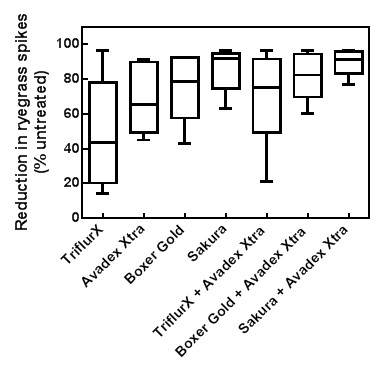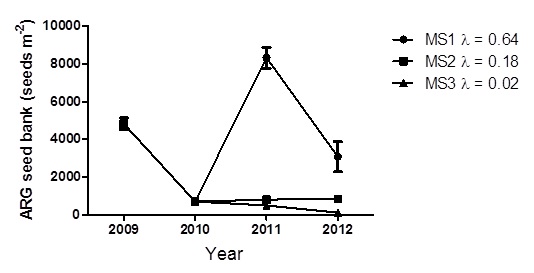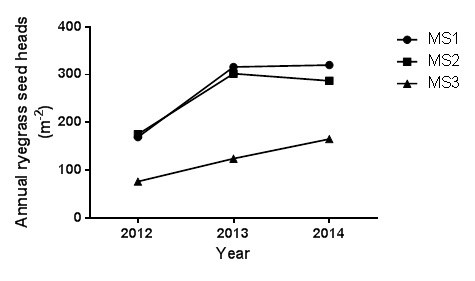Managing herbicide resistance
Author: Christopher Preston, Peter Boutsalis, Samuel Kleemann and Gurjeet Gill (School of Agriculture, Food & Wine, University of Adelaide) | Date: 18 Mar 2015
ɸExtra technical comment by Protech Consulting Pty Ltd
Take home messages
- Resistance in annual ryegrass is an increasing problem in southern Victoria.
- Using pre-emergent herbicides well is essential to controlling resistant weeds.
- Seed set control tactics on annual ryegrass are essential to reduce the impact of resistance.
Herbicide resistant grass weeds in Victoria
Random surveys show herbicide resistant ryegrass is common across all cropping regions of Victoria (Table 1). Resistance is high to the Group B herbicides, including Intervix, but generally lower to the Group A herbicides. Resistance to clethodim is present in Victoria at relative low levels. However, given the lack of other post-emergent options, resistance is expected to increase.
Table 1. Extent of resistance in annual ryegrass collected in random surveys in southern Australia. Populations are considered resistant if there is more than 20% survival.
| Herbicide tested | Region and year | ||
|---|---|---|---|
| Wimmera and Mallee 2010 |
North-eastern 2011 |
Southern 2009 |
|
| Trifluralin | 25 | 0 | 0 |
| Hoegrass | 40 | 55 | 79 |
| Glean® |
73 | 87 | 88 |
| Intervix | 18 | 29 | 39 |
| Axial® | 33 | 31 | 68 |
| Select® |
5 | 8 | 23 |
Getting the best out of pre-emergent herbicides
In the absence of effective post-emergent herbicides, ryegrass management has to rely on pre-emergent herbicides and non-chemical tactics. In getting the best out of pre-emergent herbicides it is important to understand some of their characteristics and how they will perform under different conditions.
Trifluralin and Stomp® (pendimethalin) have low water solubility so tend to stay where they are applied. Therefore, they need to be placed in close proximity to the weed seed. These herbicides are also volatile, so need incorporation shortly after they are applied to avoid losses. They bind tightly to organic matter including stubble. If there is too much stubble, some will need to be removed to get these herbicides to work effectively.
Boxer Gold® (prosulfocarb + S-metolachlor) has high water solubility and will move readily through the soil. It typically requires 5 to 10 mm of rainfall over a week to activate the herbicide. If heavy rainfall occurs after application, some crop damage may occur. Wheat is more sensitive than barley, so damage will be greater in wheat crops. Boxer Gold® has medium binding to organic matter, so will move more readily in low organic matter soils. If heavy rainfall occurs after application, some crop damage may occur. Boxer Gold® has relatively short persistence, so late emerging weeds will be a problem in high rainfall zones.
Sakura® (pyroxasulfone) has lower water solubility, making it less likely to move in soil. It requires more rainfall than Boxer Gold® to activate at 10-15 mm. Sakura® is not bound tightly to soil, but its low water solubilty means that it is normally not highly mobile. However, in soils with low organic matter or after high rainfall events some crop damage may occur. Sakura® is active for an extended period of time.
Avadex Xtra (triallate) on its own will only control ryegrass at high concentrationsɸ. It is volatile and requires incorporation. Avadex® is more mobile in soil than trifluralin and binds less tightly to organic matter. Avadex® is primarily absorbed through the coleoptile rather than the roots, so controls deeper emerging weeds (n.b. ɸAvadex Xtra is not registered to control ryegrass on its own, only when mixed with triflurX, lusta or nugran)
Rustler® (propyzamide) is similar to Sakura® in its behaviour. It has low water solubility and medium binding to organic matter in the soil. This means it usually does not move far through the profile, but can do so with heavy rain. Rustler® is registered for control of annual ryegrass (and other weeds) in canola. Canola tends to be sown shallower than wheat, so the herbicide is closer to the crop. Therefore, Rustler® damage to canola is more likely with high rainfall.
We conducted a series of six trials in high rainfall zones to determine how to get the most out of pre-emergent herbicides. Pre-emergent herbicides generally perform better in lower rainfall zones, because there is not extended germination of ryegrass that occurs in high rainfall zones. Therefore, these trials demonstrate the full value of the products. The trials also examined season long control of annual ryegrass by counting the number of seed heads present at harvest. As a rule of thumb it is necessary to reduce ryegrass populations by 97% or more in order to keep the seed bank the same.
The results are in Figure 1 as a box and whiskers plot where the mean is the line in the middle of the box and the whiskers are the range of results. Some of these trials were conducted with populations that are resistant to trifluralin, affecting the performance of this herbicide.
Sakura® on average performed better in these high rainfall environments than did Boxer Gold® or trifluralin. Adding Avadex Xtra® to any of the other pre-emergent herbicides improved control. Intended changes to registrations for Boxer Gold® will provide increased flexibility in gaining higher control of annual ryegrass populations.

Figure 1. Season-long control of annual ryegrass by pre-emergent herbicides in six trials conducted in high rainfall zones.
Breaking the ryegrass seed bank
Obtaining high control of seed set is essential for breaking the seed bank of ryegrass. We conducted a multi-year trial at Roseworthy in South Australia to determine the effects of management strategies on ryegrass seed banks. The treatments used are listed in Table 2. After the first year of oaten hay, we used a low, medium and high level of management (Management Strategies 1, 2 and 3 respectively) and measured the seed bank.
Table 2. Long-term weed management strategies investigated for the control of annual ryegrass (ARG) at Roseworthy from 2009 to 2011. All herbicides were applied at recommended label rates and timings.
| Management strategy (MS) |
Year | |||
|---|---|---|---|---|
| 2009 | 2010 | 2011 | 2012 | |
| 1 | Oaten hay | Kaspa field pea Trifluralin IBS |
Axe wheat Boxer Gold IBS |
Scope barley Trifluralin IBS |
| 2 | Oaten hay | Kaspa field pea Trifluralin IBS + Select POST |
Axe wheat Sakura IBS |
Scope barley Trifluralin IBS |
| 3 | Oaten hay | Kaspa field pea Trifluralin IBS + Select POST + Roundup PowerMax CT |
Axe wheat Boxer Gold IBS + Roundup PowerMax CT |
Scope barley Trifluralin IBS |
In this trial, the oaten hay crop reduced the high seed bank of more than 4000 seeds m-2 by more than 80% (Figure 2). However, failure to keep pressure on the population (MS 1) caused the population to rebound immediately. Two years of strong control reduced the seed bank by more than 90% and allowed a further reduction with just a pre-emergent herbicide in the wheat crop (MS 3).

A second trial was conducted at Lake Bolac in collaboration with SFS. In this trial a variety of pre-sowing cultural options were tested along with three intensities of in-crop management. The cultural treatments had no significant effect on long-term annual ryegrass populations, but the in-crop treatments did. MS 1 used cheap herbicide options based on trifluralin in cereals and triazines plus clethodim in canola, MS2 used more expensive management options based on Boxer Gold® in cereals and trifluralin plus RoundupReady® in canola, MS3 used the most expensive options based on Sakura® plus Avadex Xtra® in wheat, Boxer Gold® in barley and Rustler® plus Roundup Ready® and triazines in canola.
All herbicide management strategies resulted in an increase in annual ryegrass populations (Figure 3). However, the most intensive treatment over three years kept the increase to the smallest value. The lack of seed set control tactics in this trial is the reason why the populations remain high.

Contact details
Christopher Preston
School of Agriculture, Food & Wine, University of Adelaide PMB1 Glen Osmond SA 5064
(08) 8313 7237
christopher.preston@adelaide.edu.au
Was this page helpful?
YOUR FEEDBACK
